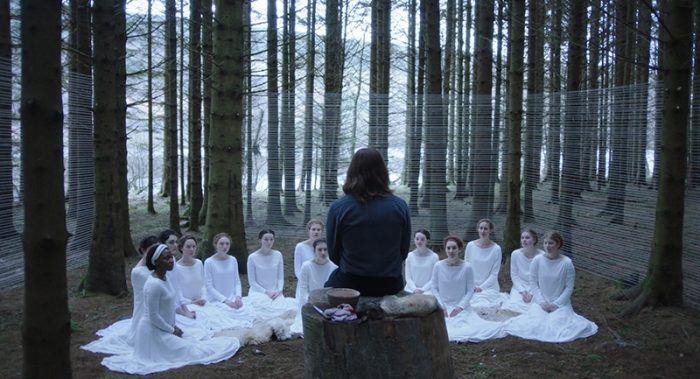
In Christianity, the lamb is symbolic of gentleness, innocence, and purity. The animal has also been used as a reference to Jesus Christ when the bible mentions “lamb of God.” There is a softness and delicate nature to the lamb, one that provides comfort in its shed fur used for blankets and clothing. They also possess a specific loyalty and obedience as they are willfully herded by a shepherd–blindly following its master even to its death. This thematic symbolism is woven throughout director Malgorzata Szumowska’s horror film, The Other Lamb, as she depicts a tale of obedience and defiance within the isolated world of a cult.
Dressed in a modest blue dress, Selah (Raffey Cassidy) is one of the daughters of a man known as Shepherd (Michiel Huisman). He leads a group of daughters and wives deep within the forest, living off the land and his empty promises of grace. The self-sufficiency of his female followers (or “flock”) is quickly established as they do all of their laundry, hunt, skin, and cook their dinner. The wives are dressed in maroon garments and are frequently patronized for their age by the daughters, although the young girls secretly long to be in their position as a right of passage and status. One wife in particular is ostracized from the group due to her impurity. The notion of being impure takes of the form of defiance and menstrual bleeding. When the daughters start their period, they are temporarily shunned and then sexually groomed by the Shepherd.
This type of fear surrounding womanhood and menstrual blood will resonate with female audiences. In modern society, there is a shame and secrecy that is unnecessarily imposed upon the biological processes women endure without choice. Women are called crazy when they have their cycle; young girls have to conceal pads and tampons as they leave classrooms to take care of their hygiene in the restroom; and horror films like Carrie capture the subsequent fear girls face when they experience their first period without proper sexual health education and guidance. The same fear consumes Selah on the first day of her menstrual cycle as she knows her life is about to drastically change not just biologically, but her status within the commune.
Like the braids that lay across Selah’s head, her faith and trust in the Shepherd slowly begin to unravel as the film progresses. She discovers she was lied to about the circumstances surrounding her mother’s death and begins to see the Shepherd as the false prophet he truly is. Haunting imagery of dead lambs flash before her eyes as her rage intensifies and she daydreams about another life–one in which she is a school girl riding in a car on the way home as opposed to trekking through a barren landscape searching for the commune’s next Eden.
Small production details support the oppression Shepherd has over his followers. For example, a blonde Barbie doll sits in the window of their home, but has been dressed in a long-sleeved maroon dress. A handful of shots focus on the doll whose popularity revolves around the fact that Barbie can be a doctor, lawyer, teacher–anything she wants. There’s an independence that is missing among the daughters and wives as they can’t even tell stories to one another, for this is an action that solely belongs to their leader. Production designer Ferdia Murphy also utilizes white string tied among the trees that are representative of the tethered patriarchy that is bestowed upon Shepherd’s followers. It also makes for a lovely aesthetic to couple with the gorgeous cinematography from Michal Englert who uses shadows and light to play to the film’s strengths of innocence and corruption. Englert worked closely with Szumowska to draw inspiration from contemporary photographers such as Jeff Wall and Gregory Crewdson.
However, the film’s savagery, unfortunately, does not fully compliment its beauty. The climactic payoff falls short in comparison to the lengthy damage that befalls on every female. The process and lengths to which they go in order to fully emancipate themselves is not entirely explored, and therefore, lacks the emotional intensity and catharsis viewers crave throughout the film’s tense runtime. And while it is a coming of age story, there is a chance that some viewers may interpret Selah’s feminine rage as a direct result of her menstruation which would feed into a narrative women have tried to dismantle for centuries. While this does not appear to be the intent of the film by any means, there is a chance it could backfire with some viewers who may not be fully versed in female biology. Regardless, the feminine strength and defiance exhibited by Selah is a beacon of light and inspiration to break free of traditional female roles, enslavement by men, and blindly following orders. Sometimes, the only leader you need is yourself and Selah embodies this notion.
In her director’s statement for Fantastic Fest, Szumowska states “at its core, this is a film about power–specifically the different ways in which it is exercised, understood, dismantled, and co-opted.” Cassidy’s performance is magnetic, and she exudes a power that all girls can relate to at various stages of their lives. A fierce and striking depiction of resiliency, writer Catherine S. McMullen wrote a screenplay that possesses a poignant relevancy which has reverberated throughout history. The Other Lamb is a festering wound of a film, one that elicits prolonged pain and suffering but offers a collective understanding. Its gorgeous imagery is juxtaposed with a growing defiance and resentment that women will know all too well.
/Film Rating: 7 out of 10
The post ‘The Other Lamb’ is a Beguiling and Rebellious Tale of Female Oppression [Fantastic Fest 2019] appeared first on /Film.
from /Film https://ift.tt/2nWJHJO
via IFTTT
Comments
Post a Comment